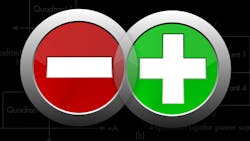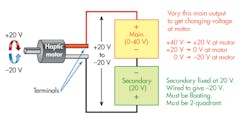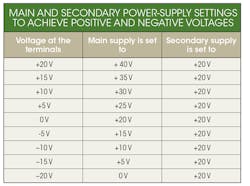This file type includes high-resolution graphics and schematics when applicable.
In 2012, I wrote two articles in Electronic Design that discussed several methods for generating a power signal that could go positive and negative in voltage using polarity reversal relays (“Turn Positive Voltages Negative with Relays”) and using bipolar power supplies (“Bipolar Power Supplies Run the Gamut”). In this article, I present a third method for generating a power signal that could go positive and negative in voltage using two dc sources.
Quick Review of Previous Methods
The lowest-cost way to achieve this goal is to use a 1-quadrant unipolar dc supply (Fig. 1a) outfitted with a polarity reversal relay. However, using a polarity reversal relay brings with it three major limitations: power interruption during polarity-reversal-relay operations; the inability to provide small positive and negative voltages; and increased test execution time due to the time it takes the relay to switch. Also, when the application requires high current, finding a suitable polarity reversal relay can be a challenge.
Another method is to use a bipolar power supply (Fig. 1b). Its main characteristic is that from a single pair of terminals, the supply can provide both positive and negative voltages. Because there’s no relay to switch polarity, a bipolar supply can smoothly move from positive, through zero, to negative voltages. It can also regulate zero volts or other very small voltages.
However, due to their design complexity, bipolar power supplies tend to be significantly more expensive than their unipolar dc power-supply counterparts. Since the majority of dc power applications can be adequately met by a standard unipolar dc power supply, most power-supply manufacturers don’t offer a wide variety of the bipolar variety.
Anti-Series for Positive and Negative Voltages
There is another alternative. You can use two unipolar dc power supplies in an anti-series configuration (Fig. 2).
In this configuration, the main supply needs to be rated for twice the maximum voltage. If you need to go from +20 V to –20 V, then the main supply needs to be rated for +40 V. In this anti-series configuration, the secondary supply is connected “backwards” and provides a constant negative maximum voltage. Therefore, in this case, it supplies –20 V.
The secondary supply must be a floating supply so that it can be connected “backwards” as a negative voltage supply. Note also that for the secondary supply, the current will flow in the reverse direction through the power supply. As a result, this supply will need to be a floating 2-quadrant unipolar dc supply (Fig. 1c) that supports positive and negative current, like the Keysight N6782A or the company's APS family.
As you can see in the table, the main supply is doing all of the work. The secondary supply stayed at a constant +20 V, but produced –20 V because it’s wired in anti-series configuration. To achieve a positive and negative varying signal at the terminals requires changing just the main supply, simplifying the programming. By using a fast dc supply as the main supply, you could generate power signals up to a few kilohertz.
An application for this would be to power up any devices that draw positive power (i.e., the device itself isn’t a power source), but need positive and negative voltage. For example, I needed to power up a motor used in a haptic feedback application for a gaming design where the motor was connected to the steering wheel in a driving simulator. When +20 V was applied, the motor turned clockwise. When –20 V was applied, the motor turned counter-clockwise. So, by quickly varying the motor’s drive voltage between +20 to –20 V, we could turn the wheel and give the gamer feedback, such as resistance to turning the wheel or bumps in the road.
With this anti-series configuration, while the total cost of the setup is twice that of a single supply, it will still be less expensive than a single bipolar power supply of the same power rating. Unlike the power supply with polarity reversal relays, the anti-series configuration will have no power interruption while the signal switches from positive to negative.
About the Author
Bob Zollo
Solution Architect for Battery Testing, Electronic Industrial Solutions Group
Bob Zollo is solution architect for battery testing for energy and automotive solutions in the Electronic Industrial Solutions Group of Keysight Technologies. Bob has been with Keysight since 1984 and holds a degree in electrical engineering from Stevens Institute of Technology, Hoboken, N.J. He can be contacted at [email protected].







